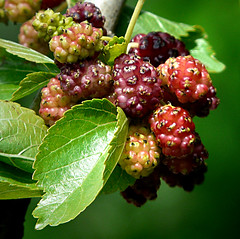| Morus alba L. (Photo credit: adaduitokla) |
| Morus nigra Deutsch: Weibliche blüten einer monözischen Art der Schwarze Maulbeere. English: Female flowers of a monoecious variety of the Black Mulberry. Français : Fleurs femelles d'une variété monoïque de Mûrier noir. (Photo credit: Wikipedia) |
| Morus nigra (II) (Photo credit: .Bambo.) |
Mulberries enjoy a long edible history and have popularly been used in pies, wines, cordials and jams. Mulberries are slowly coming back on the radar as they have been identified as a rich source of resveratrol, a compound believed to fight cancer, diabetes and the effects of aging.
It is now possible to buy extracts of mulberry leaves and fruits in many health food stores, however, I think it's more fun to grow your own.
The white mulberry (Morus alba) is the most cold-hardy, drought-and-pollution-tolerant. Unfortunately, the berries are somewhat blander than the sweet-tart red and black varieties, and there is some difficulty in knowing exactly when the berries are ripe.
Red mulberries (Morus rubra) are also drought tolerant, but they're only hardy to zone 5.
Black mulberries (Albus nigra) have the highest amount of resveratrol and anthocyanins (pigments with supposed medicinal value - they are also used as natural food coloring), but these can only grow in zones 7-9.
Mulberries are considered a "weed" tree in some places because they naturalize well and thrive with little care. Be sure to pick a deep soil in a sunny, well-drained site if you're planting mulberries and space the trees at least 15 feet apart.
The fruits can leave a mess on the ground if you just let them drop (or the birds that devour them may leave a mess of a different sort) so be sure to harvest the berries when they're ripe in late spring. The easiest way to do this is by putting a large white sheet under the tree and shaking the branches.
An alternative to growing your own mulberries is to wildcraft them. Mulberries are naturalized in many parts of the country (south of zone 5). The next time you're walking on public property, take a look around to see if you notice any mulberry plants that you can collect fruit from when ripe.
Are you willing to give mulberries a try?




when i was a child, we had a house a couple of streets over from us, that had mulberry trees--they were the only ones we were aware of in the neighborhood--we loved eating them---i think they were the black kind--thanks for reminding me
ReplyDeleteI planted 2 of the russian white mulberries along the street behind my house over 20 years ago. They are a good sourrce of food for birds and lots of people come by and pick them. I would have preferred the black ones, but I was taken in by the description of the plant in a catalog.
Deleteas a child I knew the locations of all the mulberries in my neighborhood.
Mimi Torchia Boothby Watercolors
You're welcome, glad you enjoyed the post!
DeleteLovely post and blog! Glad I found you.
ReplyDeletePop over to my blog if you've the chance. I'm the award winning author of the children's conservation series with Bella and Britt.
Wow - your books sound great. I particularly love sea turtles, can't wait to check that one out. Thanks for visiting my blog!
DeleteNot much of a berry person in general, but I enjoyed learning about mulberries. Nice to meet you through the challenge.
ReplyDeleteThank you Sheila, nice to meet you as well!
Delete